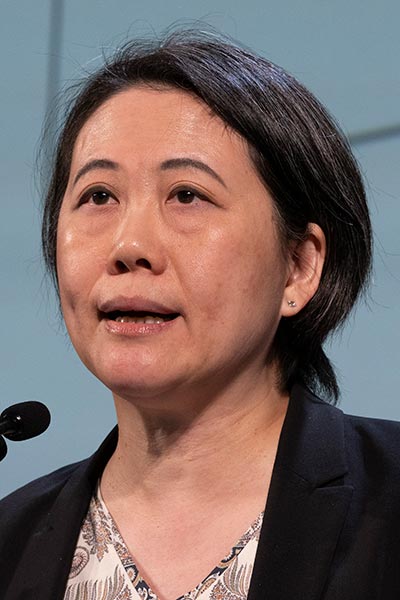Annual Meeting highlights reviewed in final plenary session
//
Estimated Read Time:

During the final session of the AACR Annual Meeting 2022, Program Committee Chair Marcia R. Cruz-Correa, MD, PhD, and three members of the Program Committee reviewed several significant highlights and important themes from the meeting.
Annual Meeting 2022 Highlights: Vision for the Future was presented on Wednesday, April 13, and can be viewed on the virtual platform by registered meeting participants through July 13, 2022.
“There’s no way to capture the scale of this meeting—19,000 people, even when scaled down because of COVID,” said Program Committee member Danny R. Welch, PhD, University of Kansas Cancer Center.
“The highlight of this meeting is that we are here,” he continued. “We’ve survived two years of isolation, politicization of a pandemic, patients not getting screened, delayed treatments, poor paylines, uncertainty of funding, diminished workforce. We’ve learned how to use tech to keep advancing our science. In the past four years, cancer researchers have initiated more than 50 initial public offerings. Clearly, nobody was resting during these trying times.”

Welch highlighted nine key themes in basic and translational research that begin with the letter M: Microenvironment, microbiome, metabolism, mitochondria, machine learning, mindset, mutualism, meaning, and medicines.
Tumor cells do not exist in isolation, they interact with the microenvironment, he said. Every analysis must recognize the different components within a tumor and the myriad interactions with the microenvironment.
Microbiota and microbiomes are the newest additions to the research agenda, he continued. Both work to shape cellular metabolism by generating substrates and supporting homeostatic balance or dysfunction.
Mitochondrial genetics have more influence on tumor behavior than previously appreciated, while metastasis remains the primary cause of morbidity and mortality in cancer, Welch said.
“Metastasis suppressors demonstrate unequivocally that metastasis is a distinct phenotype to tumor formation, yet many still equate the two phenotypes,” he explained.
Machine learning and artificial intelligence offer the promise of integrating the massive amounts of data emerging from multi-omic studies. And the resiliency shown during the COVID-19 pandemic demonstrates a mindset of focused determination to tackle critical problems with a shared vision.
“We must continue to listen to patients and partner with them to give added meaning to our research to develop new medicines moving forward,” Welch said.

Prevention, early detection, populations sciences, disparities research
Two important advances unveiled in New Orleans were new AACR working groups, said Jennifer A. Doherty, PhD, University of Utah. The new Population Sciences Working Group replaces the Molecular Epidemiology Working Group with a new title and new focus. The Cancer Prevention Working Group is a newly created group dedicated to focusing attention on cancer prevention and a progress toward a cure.
Prevention was a consistent theme during the meeting. Obesity has been identified as a risk factor for at least 16 different cancer types, Doherty noted, with clinically important effects on cancer development, systemic inflation, and metastasis.
Novel tobacco delivery systems offer the potential, or at least the promise, of reducing smoking, but the risks associated with these new systems remain a troubling unknown, she said.
Meanwhile, interception of cancer is evolving from theory to clinical practice. Biomarkers can help identify individuals at increased risk, but the available interventions, such as preventive mastectomy, may or may not be acceptable. But new approaches are in the works.
“Genomic medicine is making a difference,” Doherty said. “Multiple trials of cancer vaccines—immuno-interception—are actively recruiting and they have waitlists of patients eager to participate. The Precancer Atlas is generating new ideas in the identification of precancerous lesions, biomarkers to predict progression, and interventions.”
The science of cancer detection is another evolving area. Liquid biopsies offer the potential to screen for cancers that have no existing standard-of-care screen, she said. Improving community engagement can boost screening rates in communities that are currently underserved.
Cancer disparities and health disparities have been part of cancer care from the beginning, but multiple Annual Meeting sessions helped focus attention on both the problem and potential remedies.
“Health disparities occur along the continuum of cancer, from its initial development to detection, diagnosis, treatment, and either survivorship or supportive care,” Doherty said. “Where you live has profound impact on the care you receive.”
Studies presented in New Orleans identified mechanisms by which neighborhood red-lining, discrimination, and social and biological disparities affect patients, their families, health systems, and health providers, Doherty noted.
“This year’s meeting shows a very expanded approach to cancer—a transdisciplinary approach. We are moving to engage new partners and new disciplines—data scientists, implementation scientists, and public policy experts. Cancer research is a team sport and the more diverse the team, the better the science,” she said.

Clinical research and clinical trials
With more than 900 presenters, the AACR Annual Meeting 2022 offered a broad menu of clinical research sessions. The hottest topics fell into four broad categories: biomarker-driven precision medicine, optimal sequencing of immunotherapy with standard treatment in curative settings, immunotherapy targets beyond PD1/L1 and combination strategies, and next-generation adoptive cell therapies.
“DNA damage response is one of the hottest areas for clinical research and trials,” said Lillian L. Siu, MD, Princess Margaret Cancer Centre, Toronto, Canada. “We heard about multiple molecules targeting multiple pathways that have seldom—often never—been exploited before. Many DDR-targeted agents are in the preclinical space against multiple targets, including CNS penetration. This will become an important class of agents.”
It’s already a familiar class. Multiple PARP1/2 agents are in clinical use, with new trials showing efficacy for both familiar agents and new molecules, Siu noted. One of the most exciting approaches is selective PARP1 inhibition.
“The toxicity profile was favorable both in terms of myelosuppression and GI toxicity,” she said.
Antibody drug conjugates (ADCs) represent another evolving therapeutic area. Eleven ADCs have already been approved by the U.S. Food and Drug Administration, while multiple molecules are currently in trials and even more are in the preclinical phase with new targets.
Neoadjuvant immunotherapy is an attractive emerging strategy. Checkmate-816 is a practice-changing trial, Siu said, with very good response to neoadjuvant nivolumab plus platinum-doublet chemotherapy versus chemotherapy alone before surgery in resectable state IB–IIIA NSCLC. The hazard ratio was 0.63 favoring combination therapy with a pathological complete response rate of 24 percent versus 3 percent.
CTLA-4 is coming back into focus as a useful target. SWOG1616 showed solid benefit for nivolumab plus ipilimumab versus nivolumab alone in refractory melanoma. And MEDI5752, a novel bispecific antibody against both PD-1 and CTLA-4, had an impressive first-in-human trial debut.
Adoptive cell therapy is standard treatment for some hematological malignancies. This year brought some of the first successful results of CAR-T therapy in solid tumors. Targets included GD2, CLDN6, MAGE-A4, and up to 20 others.
“We need to infiltrate these [CAR-T] cells into tumors and keep them there as long as possible by manipulating the tumor microenvironment,” Siu said. “Going forward, we need to improve our strategies. We still have many tasks to fulfill.”




